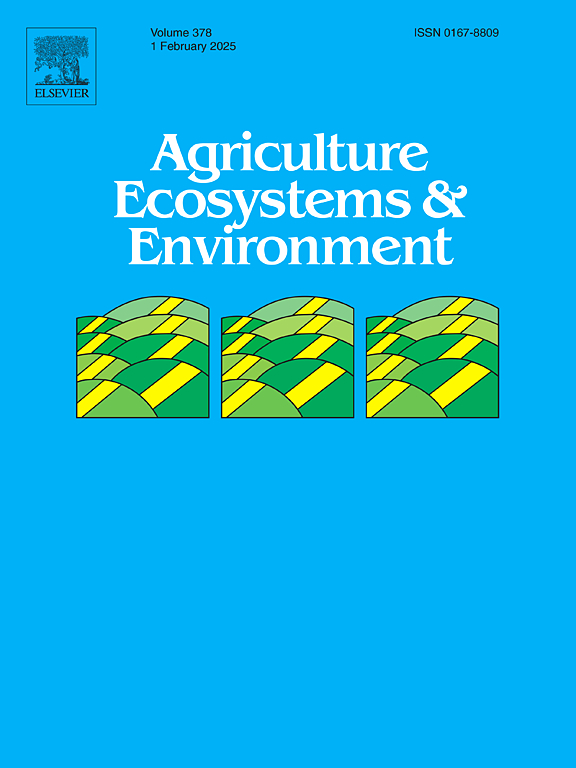Straw incorporation mitigates methane emissions by facilitating the conversion of particulate organic carbon to mineral-associated organic carbon
IF 6
1区 农林科学
Q1 AGRICULTURE, MULTIDISCIPLINARY
引用次数: 0
Abstract
Incorporating straw return into tillage systems is a potential strategy for sustaining rice production, while achieving multiple environmental benefits. The effect of different tillage management on methane emissions has been well documented; however, the combined effects with straw return management require further exploration. To investigate this, an experiment was initiated in 2008 using five management practices: conventional tillage, no tillage, conventional tillage with straw mulching, conventional tillage with straw incorporation, and no tillage with straw mulching. Changes in soil carbon pool properties, hydrolytic and oxidative enzyme activities, phospholipid fatty acids, and the abundance of methanogenic and methanotrophic genes were measured during the early and late rice-growing seasons in 2022 and 2023. The results indicated the following: (1) Straw return significantly increased cumulative methane emissions by 75.5 % compared with straw removal. However, conventional tillage with straw incorporation reduced cumulative methane emissions by 37.2 % and 20.3 % compared to conventional tillage with straw mulching and no tillage with straw mulching, respectively. (2) Conventional tillage with straw incorporation enhanced β-acetylglucosaminidase and cellobiohydrolase activities and increased mineral-associated organic carbon content compared to conventional tillage with straw mulching and no tillage with straw mulching. (3) Under conventional tillage with straw incorporation, the content of phospholipid fatty acids in bacteria, fungi, and actinomycetes increased by 7.6 %–19.3 %, 7.2 %–18.3 %, and 6.0 %–19.8 % compared with conventional tillage, no tillage, and conventional tillage with straw mulching, respectively. (4) Conventional tillage with straw incorporation reduced methanogens/methanotrophs by 14.1 % and 4.0 % compared with conventional tillage with straw mulching and no tillage with straw mulching, respectively. Structural equation modeling revealed that tillage and straw management promoted the conversion of particulate organic carbon to mineral-associated organic carbon by increasing the soil microbial populations and β-acetylglucosaminidase and cellobiohydrolase activities, which regulated methane production by methane-related functional communities. Thus, regulating the conversion of activated carbon to inert carbon through a rational combination of tillage and straw return methods can effectively reduce methane emissions from double rice paddies.
秸秆掺入通过促进颗粒有机碳向矿物相关有机碳的转化来减轻甲烷排放
将秸秆还田纳入耕作系统是维持水稻生产的潜在战略,同时实现多重环境效益。不同耕作管理对甲烷排放的影响已被充分记录;但与秸秆还田管理的联合效应还需进一步探索。为此,2008年开展了常规耕作、免耕、常规耕作加秸秆覆盖、常规耕作加秸秆还田和免耕秸秆覆盖5种管理方式的试验。测定了2022年和2023年水稻早育季和晚育季土壤碳库性质、水解酶和氧化酶活性、磷脂脂肪酸以及产甲烷和养甲烷基因丰度的变化。结果表明:(1)秸秆还田与秸秆去除相比,累积甲烷排放量显著增加75.5 %。然而,与秸秆覆盖的常规耕作和秸秆覆盖的不耕作相比,秸秆还田的常规耕作分别减少了37.2% %和20.3% %的累积甲烷排放量。(2)与秸秆覆盖常规耕作和秸秆覆盖免耕相比,秸秆还田常规耕作提高了β-乙酰氨基葡萄糖酶和纤维素生物水解酶活性,提高了矿物相关有机碳含量。(3)秸秆还田常规耕作条件下,细菌、真菌和放线菌中磷脂脂肪酸含量分别比常规耕作、免耕和秸秆覆盖常规耕作提高了7.6 % ~ 19.3 %、7.2 % ~ 18.3 %和6.0 % ~ 19.8 %。(4)常规耕作秸秆还田比常规耕作秸秆还田和免耕秸秆还田分别减少了14.1 %和4.0% %的产甲烷菌/甲烷氧化菌。结构方程模型表明,耕作和秸秆管理通过增加土壤微生物数量和β-乙酰氨基葡萄糖酶和纤维素生物水解酶活性,促进颗粒有机碳向矿物相关有机碳的转化,从而通过甲烷相关功能群落调节甲烷的产生。因此,通过合理结合耕作和秸秆还田方式,调节活性炭向惰性碳的转化,可以有效减少双稻田的甲烷排放。
本文章由计算机程序翻译,如有差异,请以英文原文为准。
求助全文
约1分钟内获得全文
求助全文
来源期刊

Agriculture, Ecosystems & Environment
环境科学-环境科学
CiteScore
11.70
自引率
9.10%
发文量
392
审稿时长
26 days
期刊介绍:
Agriculture, Ecosystems and Environment publishes scientific articles dealing with the interface between agroecosystems and the natural environment, specifically how agriculture influences the environment and how changes in that environment impact agroecosystems. Preference is given to papers from experimental and observational research at the field, system or landscape level, from studies that enhance our understanding of processes using data-based biophysical modelling, and papers that bridge scientific disciplines and integrate knowledge. All papers should be placed in an international or wide comparative context.
 求助内容:
求助内容: 应助结果提醒方式:
应助结果提醒方式:


